Enhanced Growth of Barley (Hordeum vulgare L.) by Biofertilizer Produced from Biodegraded Nile perch (Late niloticus) Wastewater
- Alternative Title
- 생분해된 Nile perch 폐액으로 만든 생물비료에 의한 향상된 보리 생장
- Abstract
- Nile perch (Late niloticus) is the most substantial and highly caught fish for export, improving economy in Tanzania. Currently in Tanzania, most of fish processing plants generate a considerable amount of waste that is directly discarded into the river or landfills. Hence, fish waste pollutes the aquatic environment and its habitat. Despite high production of fish waste, little effort has been made for biological treatment and reutilization. For this reason, the reutilization of (NPWW) as biofertilizer was investigated in this study. To examine this feasibility, the NPWW biodegradation was conducted in a 600 mL-flask scale for 72 h with the mixed culture of three Bacillus species (B. agri, B. anthracis and B. circulans). During the biodegradation, CODCr and TN removal of the culture supernatant were 52.7% and 44.3%, respectively. The test of germination index test for NPWW supernatant argue that the biodegraded NPWW was phytotoxic-free beyond 50-fold dilution. The quality of the biodegraded NPWW as a biofertilizer was verified through the hydroponic culture of barley (Hordeum vulgare L) for 14 days which showed that the leaf grew to 16.6 cm as the roots and stems elongated to 5.06 cm. The biodegraded NPWW enhanced the barley growth by 20.5% in leaf length and 22.4% stems compared with those of control. In addition, the 72-h culture supernatant exhibited highest antioxidant activities of 2,2-Diphenyl-1-picrylhydrazyl (DPPH) radical scavenging of (85.5%), 2,2’-Azino-bis-(3-ethylbenzothiazoline-6-sulfonic acid) (ABTS) radical cation decolorization (99.7%) and hydroxyl radical scavenging ability (96.7%). All the results indicate that the NPWW and used Bacillus species are potential sources of biofertilizer, and the application of the biofertilizer to agricultural industry is promising.
- Issued Date
- 2021
- Awarded Date
- 2021. 2
- Type
- Dissertation
- Publisher
- 부경대학교
- Alternative Author(s)
- Sikudhani Yahaya Mponda
- Affiliation
- 부경대학교 글로벌수산대학원
- Department
- 글로벌수산대학원 국제수산과학협동과정
- Advisor
- 김중균
- Table Of Contents
- 1. Introduction 1
2. Materials and Methods 9
2.1 Microorganisms Culture and Selection 9
2.2 Biodegradation of Nile perch wastewater 10
2.3 Analyses 12
2.4 Phytotoxicity test 13
2.5 Hydroponic culture 14
2.6 Antioxidant activity 15
2.6.1 2, 2-Diphenyl-1-picrylhydrazyl (DPPH) radical scavenging assay 15
2.6.2 2, 2’ -Azino-bis-(3-ethylbenzothiazoline-6-sulfonic acid) (ABTS) radical cation decolorization assay 16
2.6.3 Hydroxyl radical scavenging activity 17
2.7 Statistical analysis 18
3. Results and Discussion 19
3.1 Microorganisms Culture and Selection 19
3.2 Biodegradation of Nile perch wastewater 21
3.3 Phytotoxicity test 24
3.4 Hydroponic culture 26
3.5 Antioxidants activity of biodegraded Nile perch wastewater 31
3.5.1 2, 2-Diphenyl-1-picrylhydrazyl (DPPH) radical scavenging assay 32
3.5.2 2, 2’ -Azino-bis-(3-ethylbenzothiazoline-6-sulfonic acid) ABTS radical cation decolorization assay 34
3.5.3 Hydroxyl radical scavenging activity 37
4. Conclusion 40
5. Acknowledgement 42
6. References 44
- Degree
- Master
- Appears in Collections:
- 글로벌수산대학원 > 국제수산과학협동과정
- Files in This Item:
-
-
Download
 Enhanced Growth of Barley (Hordeum vulgare L.) by Biofertilizer Produced from Biodegraded Nile perch.pdf
기타 데이터 / 583.26 kB / Adobe PDF
Enhanced Growth of Barley (Hordeum vulgare L.) by Biofertilizer Produced from Biodegraded Nile perch.pdf
기타 데이터 / 583.26 kB / Adobe PDF
-
Items in Repository are protected by copyright, with all rights reserved, unless otherwise indicated.